On the mountains and rocks of Al-Hijr, you can see inscriptions in various languages known to humanity, such as Lihyaniya and Dadaniyah, as Al-Ula was the capital of the two kingdoms of Dadan and Lihyan, and other inscriptions in Latin, Nabataean and Greek. Al-Hijr also includes 110 Nabataean tombs, the most famous of which is Qasr al-Farid, which has a unique rock facade, the largest of its kind in Al-Ula.
Al-Hijr
On the desert sands of the Arabian Peninsula, Al-Hijr is located in AlUla, amidst rock formations of varying colors and sizes. AlHijr is a destination pulsating with the secrets of the ancient civilizations of Dadan and Lihyan 200,000 years ago. It is also the first heritage site in Saudi Arabia to be inscribed in the UNESCO World Heritage List, as it contains scenes in which natural wonders blend with Nabataean inscriptions and burials dating back to the first century AD.
The roots of language and ritual
The ancient tombs in Al-Hijr are an open historical museum. They contain inscriptions showing the roots of the Arabic language and stone carvings that reveal the rituals and beliefs of ancient civilizations. The number of Nabataean tombs is about 110, in which high-ranking leaders, knights, and healers were buried.

Diwan and Mount Athleb
Mount Athleb stands tall in the east of Al-Hijr. You can trace the record of the history of ancient civilizations after crossing the entrance to the “Siq”, which includes on its sides carved antiquities and Nabataean inscriptions, revealing ancient religious rituals. In the middle of it, there is a large room carved into the rocks of the mountain called the Diwan.

Jabal Al-Banat
Nabataean arts mix with Greek arts in every corner of Jabal al-Banat. It includes 29 tombs carved into rocky outcrops. Whale shapes are engraved to symbolize the guardian of the tomb.
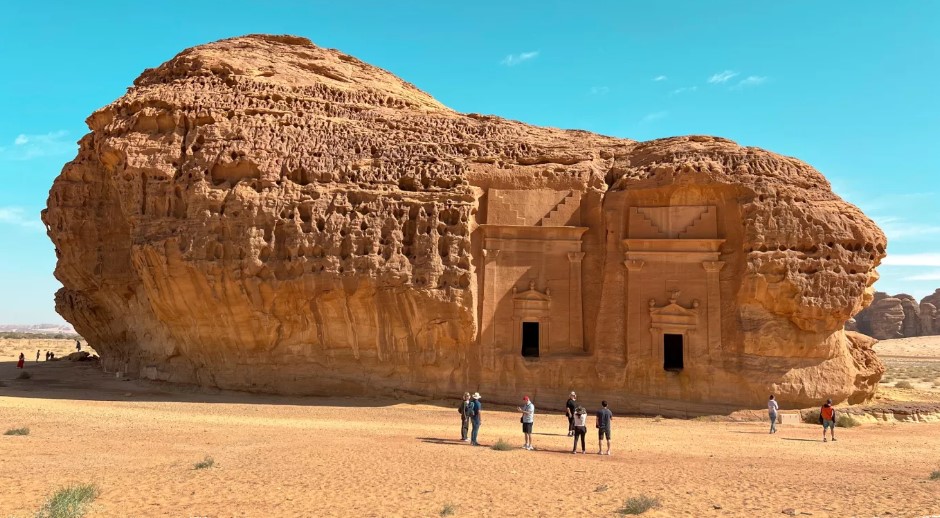
Jabal Al-Ahmar
With its red rocks and numerous tombs, Jabal Al-Ahmar hides buried Nabataean secrets that highlight the burial rituals of the inhabitants of the ancient city of Al-Hijr. It contains 18 tombs.
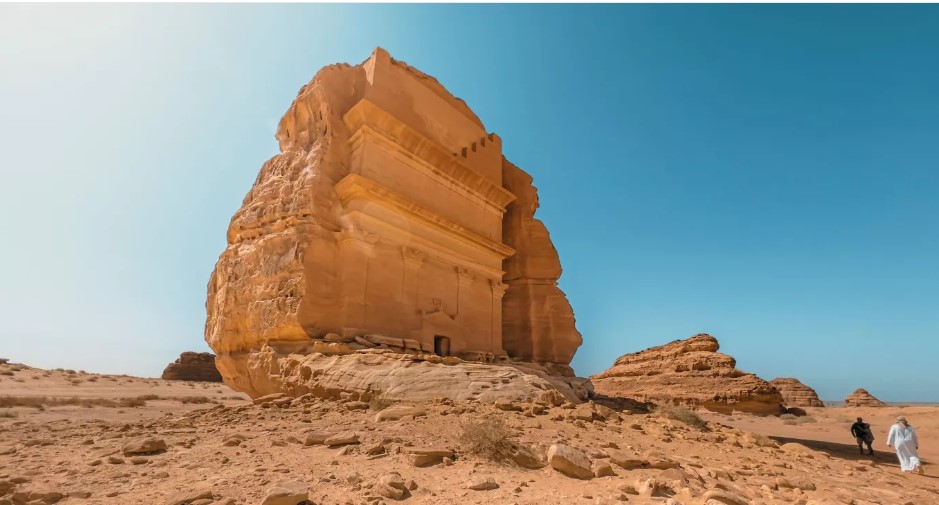
Qasr Al-Farid
Qasr Al-Farid is a 2,000-year-old historical landmark believed to have been the tomb of Lahyan ibn Koza. It is separate from the other tombs in the Al-Hijr and is the largest rock facade in AlUla.
Maraya Concert Hall
Natural beauty stimulates constructional beauty, therefore, Maraya Concert Hall was designed to be an artistic piece of work, with its mirrors reflecting the amazing natural beauty elements of AlUla surrounding the building. It is approximately 9,740 square meters, and it is in The Guinness Book of Records for being the biggest reflective building in the world.

A Cultural and Artistic Center
Maraya Concert Hall has embraced the artistic and cultural scene, entertainment shows and the biggest musical and singing concerts. It is also suitable for holding conferences and special occasions.

Local Flavors in Maraya
On the roof of Maraya Concert Hall, you will find Maraya Social Restaurant which has a unique and innovative menu combining local flavors and international recipes, started by Jason Atherton. The restaurant receives its guests from 6 pm until midnight throughout the week, except Sundays and Mondays.
Jabal Al-Fil
Natural icon
On soft golden sands, and amid captivating rock formations, Jabal Al-Fil stands as a natural sculpture that embraces the sky, with a height of more than 50 meters. It was shaped by natural factors over the years in the form of an elephant, forming a landmark of the amazing nature in AlUla.
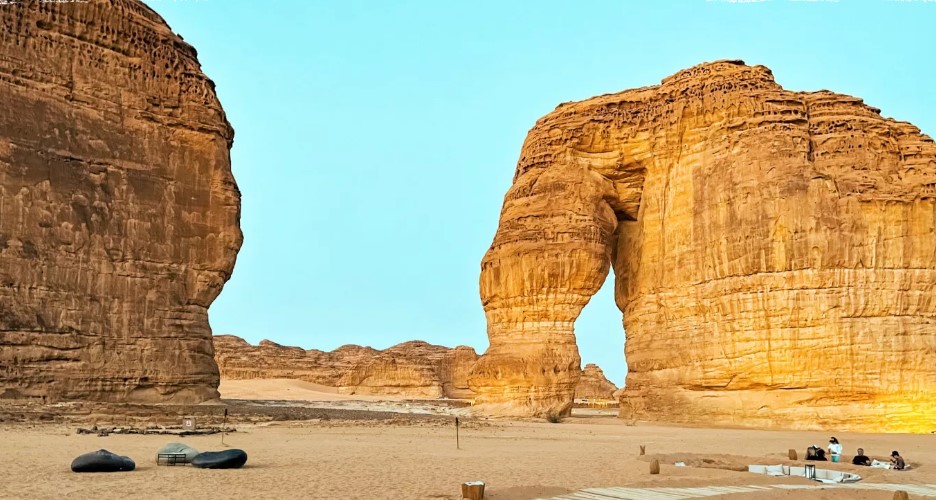
Under the sky of AlUla
You can sit and admire the reflection of the bright sun on Jabal Al-Fil in an enjoyable day outing. You can also watch the sunset behind the mountains in intimate moments accompanied by friends and family, on ground seating areas designed for relaxation and meditation. There is an international restaurant that completes your day with its delicious dishes, and free parking to park your car safely.
Visiting times
Jabal Al-Fil welcomes visitors for free during weekdays from 04:00 pm to midnight and on weekends from 04:00 pm to 02:00 am.
AlUla Old Town
The smell of history and its stories
Its ancient houses, alleys and unique design impress everyone who visits it, as its people built it in a maze-like way, consisting of 900 houses. The adjoining mud buildings constituted a means of protection from enemy attacks.
Contemplate the view
Moussa Ben Noussair Castle forms an amazing view of the town’s details. It enables you to contemplate the town’s design, the surrounding farms, and the remaining traces of houses, mosques, and markets. Although the townspeople abandoned it nearly 40 years ago, you will have the opportunity to meet their descendants in its alleys, as they tell tourists the stories of their fathers and grandfathers with pride and nostalgia.
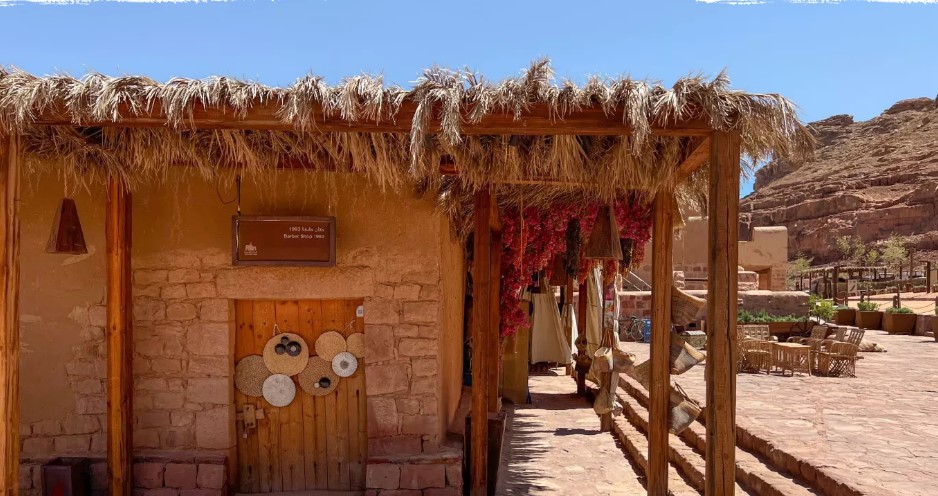
Archaeological sites near the old town
The site of the old town is characterized by many Islamic monuments, the most important one is Masjid Al-Izam in the southeast of the town. Its foundation is attributed to the Prophet (PBUH) when he stopped there to perform prayer while he was on the way to the Battle of Tabuk. It was called Al-Izam (bones) because its place was marked with bones.
Old town markets
Explore more of the old town on the western side of it. There are handicraft shops, souvenirs, clothes, and jewelry, as well as cafes and restaurants serving delicious local dishes.
The Natural Wonders of AlUla
An outdoor museum on its own curated by nature, AlUla showcases rock formations, canyons, and cliffs that rival the majestic wonders carved by its ancient settlers.
Here’s a checklist of must-see natural wonders that are bound to make your imagination wander:

Elephant Rock (Jabal AlFil)
Elephant Rock (Jabal AlFil), is an amazing geomorphological wonder located 11km northeast of AlUla. A spectacular example of natural erosive forces of water and wind over a period of millions of years, this natural wonder rises 171ft into the air with mountains looming in the background.
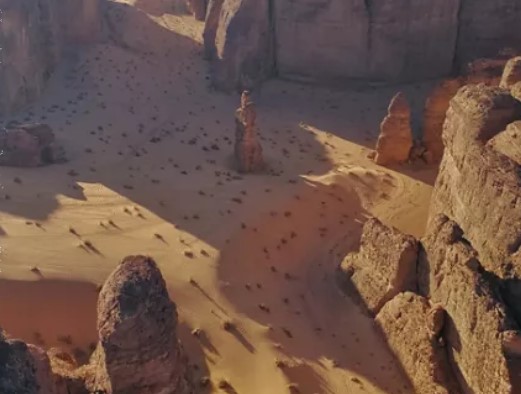
Raqasat (Dancing Rocks)
Jabal Al Rukkab, located in the Ragasat Valley, features spectacular pieces of natural art including fantastic rock formations, a network of canyons and the labyrinth of valleys running through the massif. Among these, discover a silhouette of three spiraling rock formations that are dubbed as the Raqasat (Dancing Rocks), which are sculpted by sand blown by fierce winds.
If you crave more adventure, discover the 2,000-year-old petroglyphs on the rocks in Jabal Al Rukkab
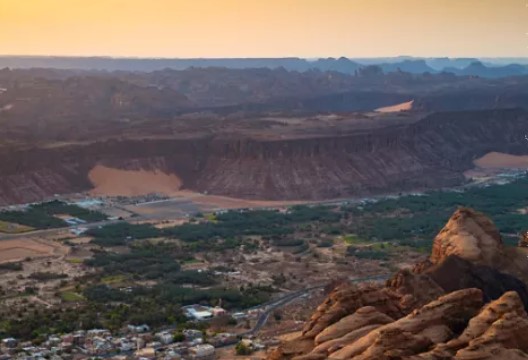
Harrat Uwayrid
Towering mesas with wide expanses of igneous basalt columns in the west add to the aesthetics of AlUla. This iconic landscape was formed over the years by a then-active volcano.
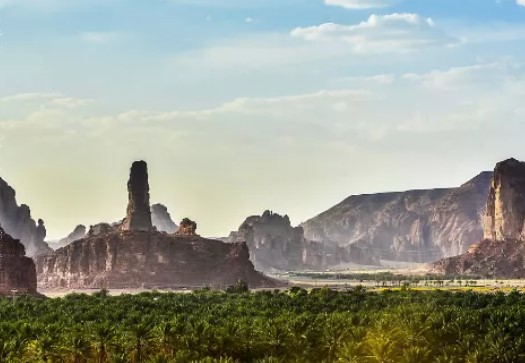
The AlUla Oasis
Nestled within the Wadi AlQura (or Valley of Villages) is the heart of the region. The AlUla Oasis is a lush haven that offers cool respite with its famous date palm groves and aromatic citrus trees along with harvests of wheat, barley, olives, figs, and oats. The AlUla Valley thrives due to the drainage basin and the oasis’s natural springs.
The Intrepid Mother's Guide to AlUla
Known historically as a place for relaxation, what better way to unwind than by booking a self-care trip to AlUla. From luxury eco-resorts to whimsical glamping, AlUla offers a variety of accommodations nestled amongst sandstone mountains and unique rock formations. Take your time tasting delicious dishes from the wide array of cafes and restaurants dotting AlUla Old Town, AlJadidah and the AlUla Oasis. Indulge in the beautiful nature and soak in the serene and peaceful surroundings.
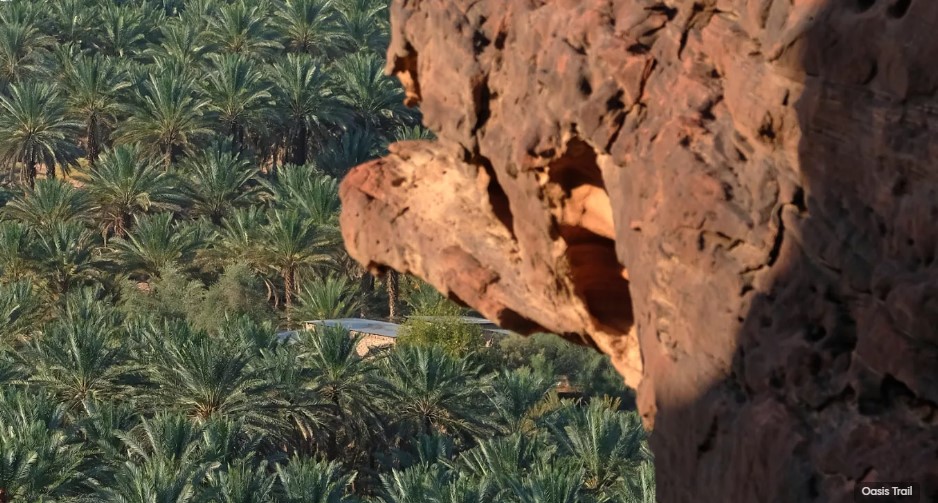
All wellness experiences will return next season
The Heritage Oasis Trail, from Dadan to the Orange Path, offers an extraordinary 3 km nature stroll through towering date palms, lush farms and historic mudbrick buildings. This beautiful trail is suitable for families and nature lovers of all ages.

The ancient maze of AlUla Old Town is characterised by its twisting alleyways and market stalls. Once a bustling stop on the famed Incense Trade Route, shopping for handmade pottery and local goods is still possible today. Then you can replenish yourself by grabbing a bite to eat or stopping for a quick cup of coffee or tea at one of the many restaurants and cafes.

Discover AlGharameel for a rare view of the milky way, free from light pollution. Millions of stars, visible without telescopes, are framed by these magnificent rock formations.
Hijaz Railway Station at AlUla
AlUla has a rich history of human civilizations that settled in it due to its location on old trade and Hajj roads, therefore AlUla Railway Station is distinguished among the other 32 stations of the Hijaz Railway and is one of its main stations. The first trip that arrived at this station was met by chieftains of AlUla in 1326AH/1907AD.
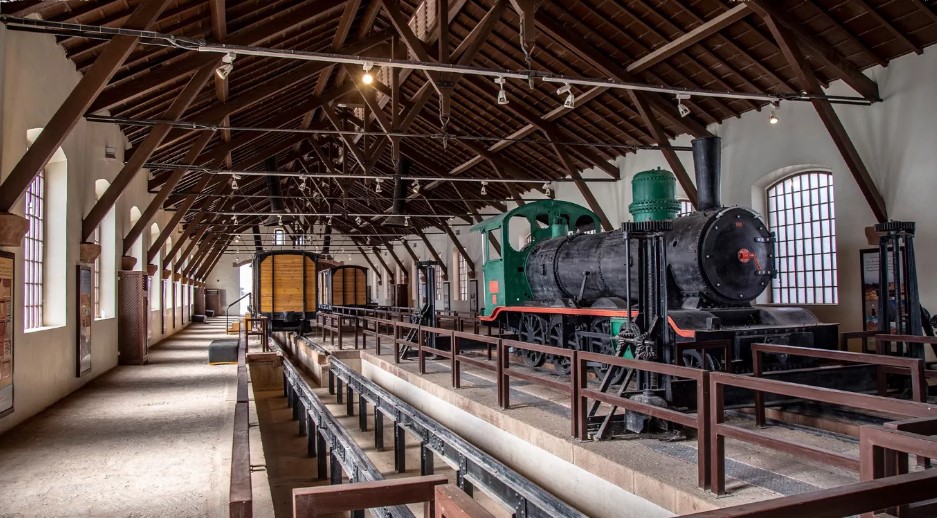
AlUla Station Museum (The Living Museum)
You will find historical evidence at the Living Museum as you wander around the wagons and observe an elegant inscription of the Hijaz name written on the wheels. Some acquisitions and monuments have survived almost a century, and you will get to know the historical characters and stories behind this project.
A Castle Near Hijaz Railway
Not far from Hijaz Railway Station lies the first site in Saudi Arabia under the UNESCO World Heritage List, and that is Hegra Castle. We advise you to visit Al-Haj Museum there.
Bin Eid Market in AlUla
Bin Eid Market is located on Al-Madinah Road and makes your stay in AlUla comfortable by providing the food and supplies you need to make exceptional moments.
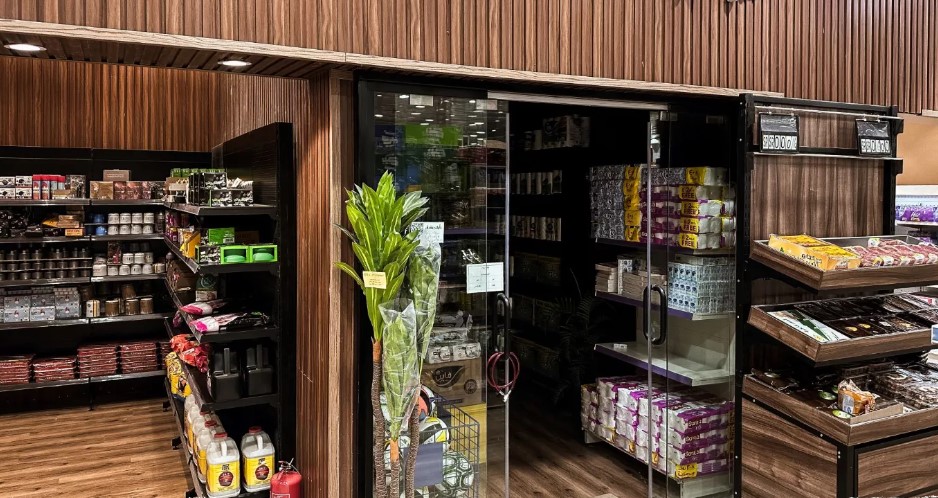
AlUla Station Museum (The Living Museum)
You will find historical evidence at the Living Museum as you wander around the wagons and observe an elegant inscription of the Hijaz name written on the wheels. Some acquisitions and monuments have survived almost a century, and you will get to know the historical characters and stories behind this project.
A Castle Near Hijaz Railway
Not far from Hijaz Railway Station lies the first site in Saudi Arabia under the UNESCO World Heritage List, and that is Hegra Castle. We advise you to visit Al-Haj Museum there.
